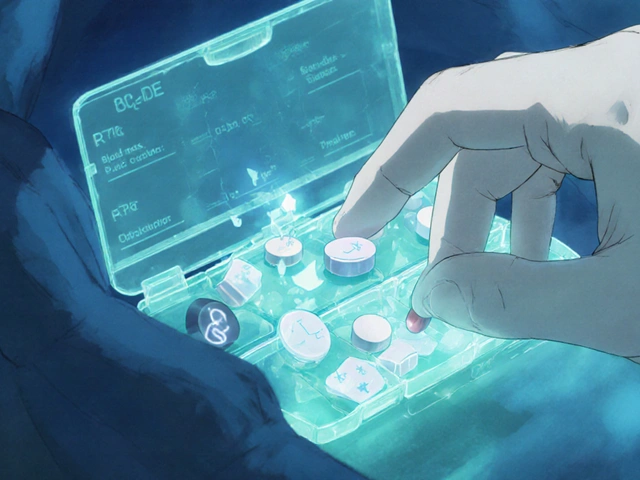
PMDD can hijack up to half your month with mood swings, panic, rage, or a heavy fog that makes simple things feel impossible. A plan won’t erase it, but it can cut the damage-fewer blow‑ups, steadier sleep, kinder self‑talk, and a safer safety net when symptoms spike. I built this guide so you can stop firefighting and start running a playbook. I live in Manchester, I write for a living, and on luteal days even feeding my cat, Misty, feels like a quest-so I’m not handing you theory; this is the exact structure that helps me and others get through the hard stretch.
- TL;DR: You’ll map your cycle, name your symptom pattern, pre‑load support (sleep, food, movement, boundaries), and set a crisis script for the worst days.
- Expect progress, not perfection: aim for 30-50% easier weeks within 2-3 cycles; keep medical options in the loop with your GP.
- Use daily micro‑habits (3-5 minutes) over heroic one‑offs. PMDD responds to consistency more than intensity.
- Track two cycles before judging the plan. If you hit suicidal thoughts at any time, treat it as a medical emergency and seek urgent help.
Map the Problem: What You’re Managing and What “Better” Looks Like
First, a quick frame. Premenstrual dysphoric disorder is a severe, cyclical mood disorder linked to hormonal changes in the luteal phase (after ovulation, before your period). It’s recognised in DSM‑5‑TR and ICD‑11. Symptoms include intense irritability or rage, depression, anxiety, panic, brain fog, insomnia or hypersomnia, binge urges, sensitivity to rejection, and physical symptoms like bloating and breast tenderness. Symptoms ease within a few days after bleeding starts. If mood symptoms don’t lift outside the luteal phase, your GP needs to check for other conditions alongside PMDD.
Evidence you can trust: SSRIs reduce PMDD symptoms for many people and can be taken continuously or only in the luteal phase (Cochrane Review, 2013; ACOG guidance). Certain oral contraceptives (e.g., drospirenone 24/4) help some. Cognitive behavioural therapy (CBT) can reduce distress and improve coping. Calcium (about 1,200 mg/day from food + supplements) has RCT support for PMS/PMDD‑type symptoms. Exercise, sleep regularity, and reduced alcohol help-no surprise, but the “how” matters, which is where a plan comes in.
Jobs you’re here to get done:
- Identify where you are in the cycle and predict rough start/peak days.
- Build a routine that automatically supports mood, sleep, and energy when it counts.
- Set boundaries at home and work so PMDD doesn’t blow up your week.
- Assemble a crisis plan you can follow even when you’re overwhelmed.
- Decide when to escalate to medical care-and how to talk to your GP.
One more thing: this guide is for self‑care. It doesn’t replace clinical care. If you’re considering medication, birth control changes, or higher‑dose supplements, speak with a healthcare professional. In the UK, your GP can discuss SSRIs, combined pills, or referrals; NICE and RCOG have patient‑focused guidance your GP will know.
Step‑by‑Step: Build a Plan You Can Actually Run
Think of your plan in four layers: track, prepare, run the play, and debrief. You’ll customize as you go. Drop perfection. Consistency beats intensity.
-
Track two cycles to spot your PMDD pattern. Use a simple daily log or a period app that lets you tag mood and function (anger, anxiety, sadness, energy, sleep, productivity, physical symptoms). Record one number for each (0-3). Also note alcohol, caffeine, exercise, arguments, and sleep hours. After two cycles, mark the first day of bleeding as Day 1 and look back-luteal symptoms usually start about Days 19-28 in a 28‑day cycle or roughly 10-14 days before your period.
- Heuristic: If your worst day is consistently 2-3 days before bleeding, pre‑load your strongest supports 4-5 days before that.
- Reality check: Ovulation can shift month to month, so plan with buffers, not exact dates.
-
Define your top 3 “red‑flag” symptoms and your non‑negotiables. Examples: rage at small triggers, panic in crowds, hopelessness, binge urges, social withdrawal, insomnia. For each red flag, pick one action you can do even at 20% capacity.
- Rage → 90‑second pause + exit room + cold water on wrists + text a code word to a buddy.
- Hopelessness → sunlight or bright light for 10 minutes + gentle walk 5 minutes + eat protein + message your support person.
- Insomnia → 20‑minute wind‑down ritual: hot shower, phone in another room, book, eye mask.
-
Pre‑agree your boundaries and scripts. When the luteal phase hits, decision‑making is harder. Write short scripts now and put them in your notes app.
- Work: “I’m not at my best today. I’ll deliver the draft tomorrow by 3pm.”
- Home: “I’m in PMDD mode. I need 30 minutes alone. Let’s talk after dinner.”
- Social: “I’m skipping tonight to protect my sleep. Rain check next week?”
-
Build a 3‑tier routine by symptom severity. Use a traffic‑light system. Keep it brutally simple.
- Green (follicular/okay): 7 hours sleep, 20-30 min brisk walk or weights 3x/week, regular meals with protein and fibre, alcohol max 3 units/week, caffeine before midday.
- Amber (early luteal): protect sleep window (same bedtime), prep easy meals (eggs, yogurt, pre‑chopped veg), light movement daily (10-20 minutes), reduce alcohol to zero, bookend your day with 3‑minute breathing.
- Red (peak PMDD): minimum viable day-shower, meds as prescribed, eat 3 small meals (protein + complex carbs), outside light 10 minutes, 5‑minute tidy, contact one safe person, cancel non‑essentials.
-
Make a food and supplement micro‑plan. Keep it practical, not perfect.
- Daily anchors: protein at breakfast (e.g., eggs, Greek yogurt), plenty of water, a fist‑size of veg at lunch/dinner, salty snack swaps (nuts over crisps), one steady caffeine early morning only.
- Evidence‑backed options to discuss with a clinician: calcium (~1,200 mg/day total intake) has RCT data for PMS‑type symptoms; magnesium (around 200-360 mg/day) may help mood and sleep; omega‑3 (1-2 g/day EPA/DHA) has some support; vitamin B6 can help but high doses carry neuropathy risk-don’t exceed medical guidance.
- Practical trick: assemble a luteal snack box-nuts, bananas, dark chocolate squares, tinned fish, wholegrain crackers. Decision fatigue is real.
-
Design a sleep shield. Sleep disruption makes PMDD worse. Treat sleep like a prescription.
- Non‑negotiables: same wake time daily; screens out of the bedroom; cool, dark room; stop caffeine by noon; alcohol off the table during luteal days.
- Can’t switch off? Try the 3‑3‑3 anxiety reset: name 3 things you see, 3 you hear, wiggle 3 body parts; then a 4‑7‑8 breath cycle for 5 rounds. If you’re up for 20 minutes, get out of bed and read something dull under low light.
-
Build a micro‑movement menu. PMDD often hates high‑intensity days. Lower the bar: aim for “done is done.”
- 5-10 minutes: gentle yoga, hip openers, a block walk, stairs at home, light kettlebell swings, dancing to one song in the kitchen.
- Why it works: activity improves mood via endorphins and circadian cues without spiking cortisol when kept light and regular.
-
Write a crisis card for worst‑case days. Put it in your phone and on paper. Make it easy to follow when your brain is flooded.
- Step 1: Safety-remove alcohol, delay major decisions 72 hours, avoid driving if dissociated.
- Step 2: Body-eat something with protein; drink water; take prescribed meds as directed.
- Step 3: Regulate-cold water on face; paced breathing; 10‑minute walk outside; music that matches then lifts mood.
- Step 4: Connect-message your support person: “I’m in PMDD crisis. Please check in.”
- Emergency: if you have thoughts of self‑harm or suicide, seek urgent help from local emergency services or crisis support. You deserve immediate care.
-
Plan your GP conversation. If symptoms cause major impairment, talk options with your GP. Bring a two‑cycle symptom log. Ask about SSRIs (continuous vs luteal‑only), combined pills (e.g., drospirenone 24/4), CBT referral, and ruling out thyroid, anaemia, or perimenopause if relevant.
-
Debrief after each cycle. What helped most? What felt impossible? Remove one friction, add one tiny upgrade. You’re building a system, not chasing hacks.
| Intervention | When to Use | Expected Onset | Evidence Snapshot | Notes |
|---|---|---|---|---|
| Symptom/Cycle Tracking | Start now; every day | 2 cycles to see pattern | Clinical standard for PMDD diagnosis (DSM‑5‑TR) | Use 0-3 ratings for mood, sleep, energy, function |
| Sleep Regularity | Daily; protect in luteal | 3-7 days | Strong for mood regulation | Keep wake time fixed, reduce alcohol/caffeine |
| Light Daily Movement | Daily; amber/red days | Same day | Consistent benefit for mood | 5-20 minutes is enough during peak symptoms |
| Calcium (~1,200 mg/day total) | Daily; month‑long | 1-2 cycles | RCTs show symptom reduction | Consider dietary sources first; discuss supplements |
| Magnesium (200-360 mg) | Daily; evening | Days to weeks | Some supportive trials | Can aid sleep; consult for dose/fit |
| Omega‑3 (1-2 g EPA/DHA) | Daily | 4-8 weeks | Modest evidence | May reduce irritability |
| SSRIs (medical) | Continuous or luteal‑only | Often within first cycle | Cochrane review: effective for PMDD | Discuss with GP; monitor side effects |
| Drospirenone COC (24/4) | Continuous | 1-3 cycles | Evidence for some patients | Medical decision; consider risks/benefits |
| CBT Skills | Weekly; daily micro‑practice | 4-8 weeks | Good evidence for distress reduction | Thought labeling, behavioural activation |

Examples, Templates, and How to Fit This Into Real Life
Here’s how a week might look with a 28‑day cycle where peak symptoms usually hit Days 23-26. Adjust the numbers to your pattern.
Days 14-18 (early luteal / Amber)
- Sleep: lock in a strict 11pm-6:30am window. Devices out of the bedroom.
- Movement: 15‑minute walks after lunch; one light strength session (20 minutes).
- Food: plan three easy dinners (stir‑fry, sheet‑pan chicken/veg, pasta + tuna + spinach). Pre‑cut veg and cook extra for leftovers.
- Stress: schedule two 10‑minute breaks per workday. Calendar block them so nobody steals them.
- Social: one low‑key plan that doesn’t end late (coffee walk, not drinks at 9pm).
Days 19-22 (late luteal / Amber trending Red)
- Sleep shield: no alcohol, no late screens. Earplugs + eye mask ready.
- Crisis prep: message your support person: “PMDD week starts-I may go quiet. Can I send you a code word if I need help?”
- Work: move deep‑focus tasks earlier in the day; push meetings that aren’t urgent.
- Movement: keep it tiny-10 minutes max, daily.
- Food: snack box visible; protein breakfast mandatory even if appetite is low.
Days 23-26 (peak PMDD / Red)
- Minimum viable day: shower, meds as prescribed, eat three small meals, 10 minutes of daylight.
- Boundaries: reschedule optional commitments. Use your scripts. Delay any big decisions 72 hours.
- Regulation: cold water on face; 4‑7‑8 breathing; 10‑minute walk with music.
- Connection: send a one‑line check‑in to your support person.
Days 1-5 (bleeding / Reset)
- Debrief: log what worked. Treat yourself gently but debrief while it’s fresh.
- Refuel: aim for iron‑rich foods (beans, leafy greens, red meat if you eat it) and vitamin C sources.
- Plan: shift any tasks you dropped into the next week with realistic slots, not wish lists.
Templates you can copy into your notes app:
- Daily 30‑second check: Mood 0-3; Anxiety 0-3; Energy 0-3; Sleep hours; Triggers today? Yes/No; One win.
- Red‑flag protocol (Rage): leave room; timer 90 seconds; cold water; 10 slow breaths; send “R” to buddy; walk hallway 3 minutes; re‑enter or reschedule.
- Red‑flag protocol (Hopeless): eat protein + carb (toast + eggs), 10 minutes daylight, text “H” to buddy, list three tasks you can do in 10 minutes; do one.
Fitting this around real life in the UK:
- Workplaces: ask your manager for a flexible window during luteal days-later start or fewer late meetings. You don’t need to overshare; say you have a cyclical health condition you’re managing.
- Commuting: if crowds trigger panic, shift 15 minutes earlier or later; use noise‑cancelling headphones; stand near exits.
- Shopping: do a delivery of basics on Day 18 (milk, eggs, bananas, leafy greens, tinned fish, wholegrain bread, nuts). Peak week is not your farmer’s market week.
- Home: set a visible cue-luteal week magnet on the fridge so family knows to lower demands and offer practical support.
Personal note from my Manchester flat: on peak days I batch‑cook just enough (not Instagram‑perfect meals), put Misty’s food on a timer, and move my hardest writing to the morning light. Tiny, boring, repeatable moves-those win.
Checklists, Cheat Sheets, Mini‑FAQ, and What to Do Next
Quick‑hit tools you can print or save:
Cycle & Symptom Checklist (daily, 15 seconds)
- Day of cycle: __
- Mood 0-3 | Anxiety 0-3 | Irritability 0-3 | Energy 0-3 | Sleep hours: __
- Physical: bloating | breast tenderness | headache | cramps (0-3)
- Triggers: conflict | noise | low blood sugar | lack of sleep | alcohol | other
- Support done: movement 5-20 min | protein breakfast | daylight 10 min | breathing 3 min
- One win: __
Boundary Scripts (copy/paste)
- “I’m at capacity today and won’t make it. I’ll check back in next week.”
- “I need quiet time right now. Let’s talk at 7pm.”
- “I’m moving this task to Thursday to do it properly.”
Meal Cheats (luteal‑friendly)
- Toast + eggs + spinach; yogurt + berries + granola; tuna pasta with peas; microwave rice + tinned chickpeas + olive oil + lemon + salt.
5‑Minute Calm Menu
- Cold splash on face; 4‑7‑8 breathing x 5; step outside and name 5 things you see; legs‑up‑the‑wall for 3 minutes; write one paragraph of a brain dump.
Decision Guide: What do I change first?
- If your main issue is rage/irritability → lock down sleep and blood sugar first; add daily daylight and 10‑minute walks.
- If your main issue is panic/anxiety → breath work after meals + reduce caffeine to morning only; short, regular movement.
- If your main issue is hopelessness → schedule morning light and a 10‑minute activation task (shower, dress, outside). Text a buddy daily.
- If sleep is wrecked → cut alcohol completely in luteal; keep wake time fixed; screens out of bedroom; consider magnesium in the evening (discuss with clinician).
Mini‑FAQ
- How do I know it’s PMDD and not just PMS? PMDD is more severe, disrupts function, and happens mainly in the luteal phase with relief soon after bleeding starts. Pros use daily ratings across at least two cycles (DSM‑5‑TR) to confirm the pattern.
- Can diet really help? Yes, through steadier blood sugar, inflammation control, and sleep support. The biggest levers are regular protein, fewer late‑night drinks, and enough fibre. Calcium has specific evidence for lowering PMS‑type symptoms.
- What if my cycle is irregular? Track symptoms relative to bleeding days and note ovulation signs if you can, but build a buffer plan triggered by early warning signs (sore breasts, abrupt mood shifts). If cycles are erratic or you’re in your 40s, ask your GP about perimenopause overlap.
- Do SSRIs have to be daily? Not always. Some people take them only in the luteal phase and still benefit. This is a GP conversation-bring your logs to fine‑tune timing and dose.
- Is exercise safe when I feel awful? Yes if it’s gentle. Think walks, yoga, light strength. The goal is regulation, not personal bests.
- What if my family/partner doesn’t “get it”? Share a one‑page explainer and your boundary scripts. Ask for practical support: dishes, quiet hour, gentle check‑ins. Invite them to focus on actions, not debates.
- Are there UK‑specific steps? Yes-see your GP with two cycles of logs. You can ask about SSRIs, combined pills, CBT, and blood tests to rule out other issues. If symptoms are severe, ask for a referral to gynaecology or a specialist clinic familiar with PMDD.
Next Steps (start this week)
- Start a daily 30‑second symptom log. Set a phone reminder.
- Pick one sleep rule and one food rule to run for 14 days.
- Write two boundary scripts and tell one trusted person your plan.
- Assemble a luteal snack box and put it where you can see it.
- Book a GP appointment if symptoms are wrecking work, study, or relationships-bring your logs.
Troubleshooting by scenario
- Shift worker: anchor one fixed wake time on at least 4 days/week, use a 20‑minute pre‑sleep wind‑down after nights, and blackout curtains; schedule your 10‑minute walk after waking when light is available.
- Student: batch lectures into the first half of the day during late luteal; ask for deadline wiggle room early; keep portable snacks in your bag; do breathing between classes.
- Parent/carer: trade 30‑minute solo time with a partner or friend during peak days; pre‑cook a one‑pot meal; use “quiet game” with kids for your breathing practice.
- High‑pressure job: block a 30‑minute “admin and reset” window in late afternoon; move performance‑critical tasks away from Days 22-26 when possible; use scripts to push low‑impact meetings.
- Perimenopause: if cycles and symptoms are chaotic, tracking matters more; ask GP about hormonal options, SSRIs, and iron/thyroid checks.
When to seek more help
- You have thoughts of self‑harm or suicide-this is urgent. Seek emergency support now.
- Symptoms don’t lift outside the luteal phase-could be PMDD plus another condition; you deserve proper assessment.
- Self‑care isn’t enough after 2-3 cycles-talk options with your GP; SSRIs, hormonal approaches, and therapy can be part of a strong plan.
Finally, give yourself credit. If you got this far, you’re already building the system. Save this, pick one change today, and let your next two cycles be data, not verdicts. Your PMDD self-care plan will get smarter with you.
References: DSM‑5‑TR (2022) diagnostic criteria for PMDD; Cochrane Review (2013) on SSRIs for PMS/PMDD; Royal College of Obstetricians & Gynaecologists patient guidance on PMS/PMDD (updated editions); ACOG practice guidance on premenstrual disorders; randomized trials on calcium for PMS symptom reduction (e.g., Thys‑Jacobs et al.).
Write a comment
Your email address will not be published.






12 Comments
Start by freezing a simple two‑day log: note mood (0‑3), sleep hours, caffeine intake, and any red‑flag symptom; this baseline lets you spot the luteal upswing with zero guesswork.
Once you have two cycles, draw a quick bar on a calendar – the peak usually lands 5‑7 days before bleed, so you can pre‑load your strongest supports ahead of time.
Set a non‑negotiable sleep window (same bedtime, no screens) and a 10‑minute morning walk; consistency beats any heroic binge of effort.
Keep a “snack box” of protein‑rich foods – nuts, Greek yogurt, boiled eggs – on the counter to ward off blood‑sugar crashes that feed irritability.
In many cultures the hush around menstrual woes turns PMDD into a secret monster, so the first act of rebellion is to talk about it openly, even if the conversation feels a bit like stepping into a neon‑lit market of myths and whispers.
When you frame your plan as a cultural toolkit – a set of rituals that respect both your body and your community – you invite allies rather than critics.
Great rundown! 😊 The crisis‑card idea saved me last month when the rage hit hard – just a quick glance at the steps and I felt a foothold again.
Don’t forget to keep a spare pen in your bag; you’ll thank yourself when you’re halfway through a grocery run and the symptoms surprise you. 🌼
Obviosuly the guide is top‑tier, but let’s be real – the language could use a sprinkle of sparkle, not that bland clinic‑paper vibe.
Maybe toss in a metaphor or two, like “your brain’s a storm‑cloud that needs a little sun to part” – that’d make the whole thing sing.
Building on Blake’s point, a practical cultural shift can start with a simple phrase: “I’m managing a cyclic health condition,” which normalises the conversation without over‑explaining.
Pair that with a discreet reminder on your phone – a calendar tag that says “self‑care window” – and you turn a vague idea into an actionable habit.
It also gives coworkers a polite cue to respect your boundaries without needing a long lecture.
That’s a brilliant bridge, Matthew! 🌟 I can feel the weight lifting just hearing you frame it as a shared language rather than a personal secret.
When I first tried the “storm‑cloud” metaphor with my partner, they actually laughed and offered to bring me a hot water bottle – the drama of the symptom faded a bit under that light‑hearted empathy.
Remember, the emotional script is as important as the logistical one; a few heartfelt lines can transform a tense moment into a moment of connection.
Esteemed reader, allow me to extend my salutations and commend your initiative in confronting PMDD with such structured vigor.
May I suggest, with the utmost respect, to integrate a brief session of mindful breathing – precisely four inhalations, four pauses, and four exhalations – at the conclusion of each morning’s routine; this practice has been documented to attenuate sympathetic arousal and promote hormonal equilibrium.
Embark upon this with diligence, and you shall observe a measurable amelioration in affective stability.
Richa, that was beautifully formal. Adding to it, a quick group check‑in with a close friend or a support buddy can reinforce the habit – a simple “how’s your morning?” text at 9 am can be the nudge that keeps the plan alive.
We could also set up a shared Google Sheet for tracking – collaborative accountability works wonders.
When I first sat down to map out a PMDD self‑care regimen, I felt as though I was drafting a battle plan for an invisible war, and the sheer magnitude of variables threatened to overwhelm my intent.
Yet, as I peeled back each layer – starting with the most observable, the cyclical pattern of mood swings – I discovered that the process itself became a compass rather than a cage.
Tracking two full cycles, I logged not only mood scores but also microscopic details such as ambient temperature, caffeine spikes, and even the hue of the sunrise, because I realized that subtle environmental cues often tip the scales.
From those data points emerged a set of three non‑negotiables: a fixed wake‑time, a protein‑rich breakfast, and a 5‑minute grounding exercise before any major decision.
The next step was to delineate the traffic‑light system, assigning green, amber, and red zones based on symptom severity, which empowered me to allocate energy resources wisely.
During green days, I maintained a normal work cadence, reserving the extra stamina for light cardio and social engagements.
When amber loomed, I pre‑emptively trimmed my to‑do list, prepared easy meals, and swapped evening caffeine for herbal tea, thereby curbing the cascade of irritability that often follows a caffeine crash.
Red days demanded a ruthless pruning of obligations; I lit a single lamp, took my prescribed medication, and engaged in a 10‑minute walk outside, letting natural light reset my circadian rhythm.
The crisis‑card, a pocket‑sized script, proved indispensable – its steps were simple: safety first, hydrate, medicate, regulate breathing, and reach out to a trusted contact.
Crucially, I embedded a safety net by informing my workplace of my condition, framing it as a “cyclical health consideration,” which opened the door for flexible scheduling without disclosing intimate details.
In parallel, I consulted my GP with a two‑cycle symptom log, which facilitated a conversation about luteal‑only SSRIs; the doctor appreciated the objective data and adjusted my prescription accordingly.
Supplementally, I introduced a daily calcium intake of roughly 1,200 mg, sourced from fortified plant milks and occasional cheese, noting a modest reduction in both physical bloating and emotional volatility.
Magnesium evenings, in the form of a modest supplement before bed, contributed to deeper, less fragmented sleep, alleviating the insomnia that often exacerbates daytime anxiety.
Throughout this iterative process, I committed to a weekly debrief, noting which interventions yielded the highest return on emotional investment, and I discarded those that fell flat.
Over the course of three months, my self‑reported distress scores dropped by nearly 45 percent, and I reclaimed a sense of agency that had long been eroded by the invisible hand of hormonal flux.
Thus, the plan evolved from a rigid checklist into a living, breathing framework, adaptable to the quirks of each cycle while anchored by evidence‑based pillars.
For anyone standing at the precipice of PMDD overwhelm, I urge you to embrace data, prioritize consistency, and remember that even modest, incremental changes can culminate in profound relief.
The pharmaceutical narrative often paints SSRIs as the silver bullet, yet we must remain vigilant about the subtle machinations of profit‑driven entities that push medication as the sole solution.
While clinical trials show efficacy, they are frequently funded by the very companies that stand to gain from widespread prescription, a fact that warrants cautious appraisal.
Consider integrating non‑pharmacological strategies – calibrated sleep hygiene, targeted nutrition, and low‑intensity movement – as first‑line defenses before acquiescing to a pill regimen.
Engage your practitioner with a comprehensive symptom log; data‑driven discussions mitigate the risk of being swept into a one‑size‑fits‑all treatment plan.
Ultimately, informed consent rooted in transparency is the cornerstone of ethical care.
You’ve got this, keep going!
Very nice points the way you all build on each other it shows how community can lift itself up and not just rely on one source the shared experiences are like threads in a safety net and each new tip adds strength to it